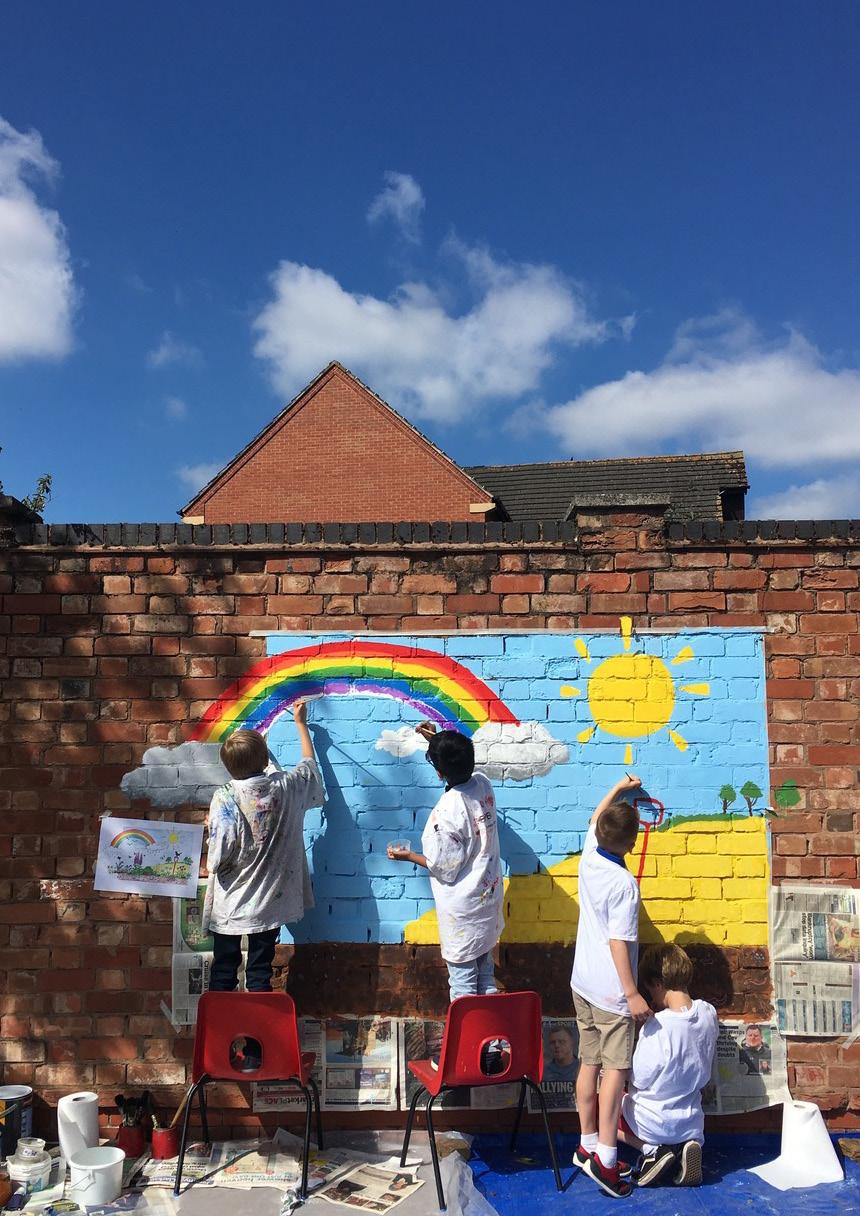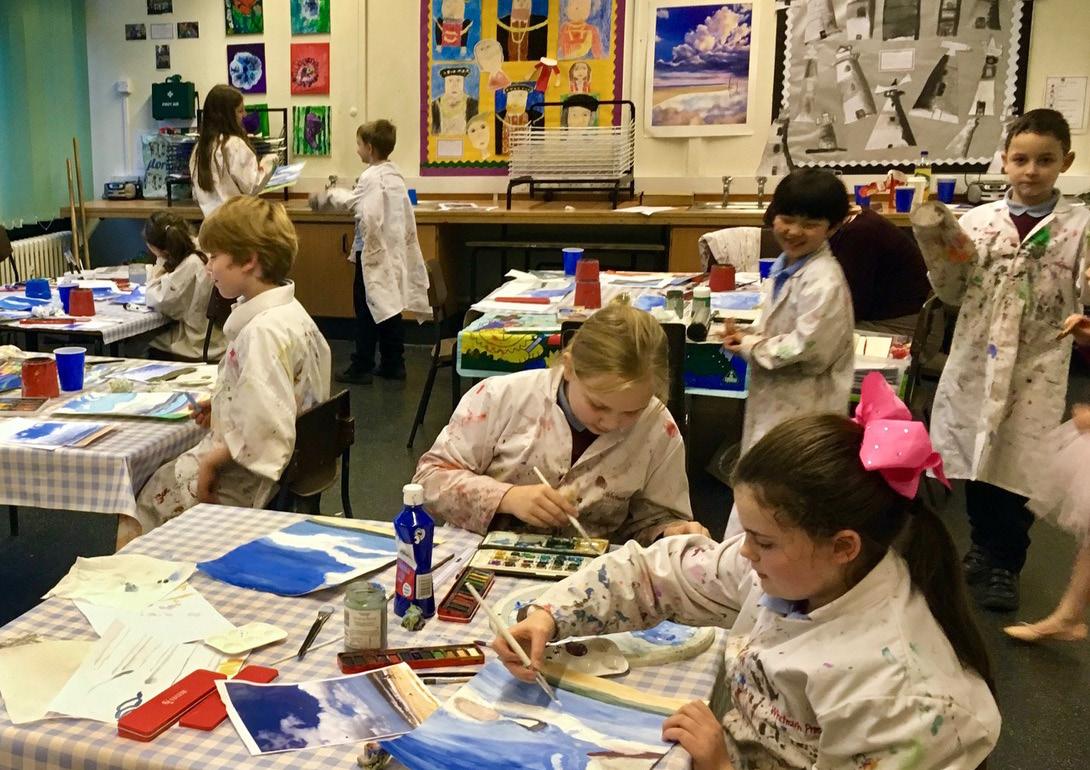
7 minute read
The art of learning
Lynne Gougeon is an LSA member of talent and distinction, helping in local primary schools.
According to the World Economic Forum, by 2020 creativity will be in the top three most important skills for future jobs.
Advertisement
Right from prehistoric times, art and creativity have been a fundamental part of the human experience. Early man surrounded their dwellings with images of their lives and understanding of the world. And if the quote above is true, it shows no sign of changing. Indeed, as the world becomes more and more automated, the creative sector is surely only going to increase in importance. In November 2018 it was worth over £1 billion to the UK economy. Careers in fashion design, advertising, computer gaming, fine art, stage and set design, photography, graphic design, interior styling (I could go on and on) all start with a grounding in art.
So, shouldn’t we be placing more importance on art within our schools?
Instead, art along with other subjects such as music and drama, is being squashed out of the curriculum due to ever increasing academic demands, squeezed budgets and time pressures on teachers. And as children spend more and more time at home on screens, shouldn’t we encourage time getting messy and creative in schools?
I was lucky enough to grow up in an artistic family. Both my mother and grandfather taught and guided me and from a young age let me use their ‘proper paints and brushes’. I am very happy to be able to do the same now for my children. Our house is filled with their drawings and creations. They are encouraged to ‘see’ the world around them, the colours, textures, shapes and patterns, just as I was. It not only makes them more observant, it makes the world a far richer and more interesting place for them to be.
Through the varied and changing activities of childhood, art was always the constant for me. This love followed me through my schooling; GCSEs, A Levels, Art School and Degree, leading to a career in advertising. I continued to paint and sell commissions throughout and then, once both my children were at school, I decided to make art my full-time career. I was expecting this to be through selling my paintings and photography but, as is often the case, another opportunity presented itself…
I was asked to help with an art project at my children’s school, which was quickly followed by another. And another. And another. I realised I loved teaching and the kids loved art. I started an after school art club at Whitnash Primary School and then was challenged by LSA Trustee David Phillips to create an exhibition at East Lodge Gallery of the pupils’ and my work. The success of this show in March 2018 led to Clapham Terrace Primary School asking me to help them do the same in February this year. This was another joyful exhibition full of fabulous, colourful work by lots of very proud children.
With various other projects from a mini exhibition in a phone box to batiks on the theme of evolution at Milverton School, from world history timelines to playground murals, teaching opportunities keep on presenting themselves. I now teach weekly at Whitnash Primary School, run my after school club there, and have regular sessions at Clapham Terrace School, as well as private tutoring.
We have been doing projects on volcanoes, Tudors, self-portraits, World War II, space, seascapes, animals, local landscapes, sea creatures, flowers and architecture. Children have been using pastels, water colours, batiks, acrylics, oil pastels, pencils, photography and mixed media. Not only have these artworks been shared in class, with parents, in school newsletters, on Facebook pages and Twitter feeds, but also in public exhibitions and local press (not least ArtSpace – thank you). I am delighted to say that many of my students will also have the chance to have some of their work on display in this year’s Art in the Park Festival. A thrill for any artist but for those so young it is a really important and exciting opportunity. There have been so many positive experiences during all these different lessons and projects. However, as I am sure teachers so often experience, I wanted to be able to give the children more of my time and attention than 2 hours with 30 children would allow. So, this led me to approach Whitnash Primary School with an idea of one-to-one classes for some pupils. With generous funding from Whitnash Councillor


Judy Falp for trial classes, I have been able to work with five children age 7-11 years to see if it would bring any of the benefits I believed it would. I am happy to say it has.
Now, I am not an art therapist and they are not art therapy classes, but I believe having oneto-one support, guidance and encouragement is a therapeutic experience. It is a relaxed 30 minutes where the child has no academic pressure but can enjoy learning and experiencing new art techniques. Unlike in many of their lessons, their work is not right or wrong, it is simply theirs.
Almost every week I see another article about the benefits of art on our wellbeing. It is even being prescribed by some GPs. When we create art, we are in the moment, present, mindful. Phones and other distractions take a backseat. In a busy world full of information, pressures, results and academics, we are starting to rediscover the simple pleasure of just creating - surely this is therapy in itself, whatever the medium you choose.
As with many of my lessons I have felt it is important to start with the basics and introduce children to the different media and terminology. I want to help them to understand the cost of art supplies so that they do not waste materials, but treat them with respect - and not squeeze out half a tube of black paint in one go! We test out the ‘smudginess’ levels of different pencils, we learn how to blend pastels and keep more of it on the paper than on their clothes. We learn to look after our brushes and not to leave them standing in water pots. We learn the importance of clean water and how not to mix paints like we are stirring a cake. Then we learn how to clean up!
How can we expect children to use the tools properly and produce work they are happy with if they are not first given the instructions on how to use those tools? It is great getting them to produce artworks in the style of Matisse, but surely it is more important to teach them how to control the brush and paint first?
I also teach them it is okay to make mistakes, you do not need to panic, things can be changed/ corrected. Learn the rules, then decide if you want to break them! Art is subjective, if I make ‘corrections’ they are my opinions, argue with me if you like. Put your point of view across. Make creative decisions. Does it look right? Are you happy with it? Can you do better? Always look, take your time, think. But most of all, have a go. I often hear ‘I can’t do art’. I say you can. You might find it really difficult, that’s ok, we can work with that. We can’t work with ‘can’t’.
Each of my one-to-one pupils has progressed and surprised themselves and their teachers. From improved pen grip leading to better handwriting, to accepting compliments and gaining enough confidence to show their work to the class, sometimes even the whole school in assembly.
And through all my different sessions across the schools, I have seen improvements in attention, perseverance, control, awareness, focus and self-esteem. An effervescent enthusiasm for every project from some children and a quiet sense of achievement in others. Children not overly interested in school have been going home and telling their families all about it. Children have been practising things at home and bringing them in to show me in the next lesson. I have seen the excitement and surprise on their faces when they try out a new medium for the first time or as they watch their creation develop. There is always a real sense of pride as they show their work to their friends and great encouragement and enthusiasm as they look at the work of others. It is such a privilege to share in a child’s joy as they discover they can do something they didn’t think they could.
I firmly believe that art is not separate from other learning. It opens the mind and can connect, complement and enhance all other topics and areas of study, from language to mathematics and everything in between. It helps develop confidence, resilience, observation, ideas, opinions, a willingness to try and to experiment. Art encourages a greater awareness of the world around us and indeed, a better understanding of ourselves.
As a Warwick University report said, ‘We need creative scientists as much as we need artists who understand the property of materials and the affordances of new technology.’
So, what started for me as painting pastel portraits of Jon Bon Jovi in my parents’ kitchen as a child, led to a career in advertising and now to me helping other children experience and enjoy art.
Where could that take them?.










